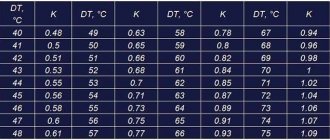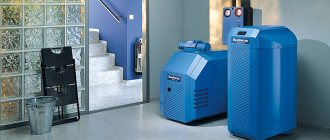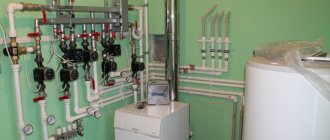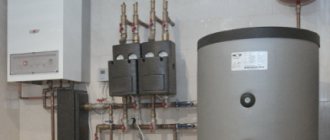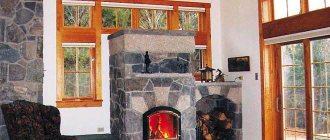Gas convectors are modern devices for autonomous heating, representing an alternative to traditional central heating batteries. They are able to provide an automatic mode with a sanitary temperature inside the room. The great thing is that the devices do not require connection to either electrical or heating networks. They are very economical because during their operation they do not have losses along the length of pipelines, which are present in traditional heating schemes and sometimes reach 20% of the total load of the facility. The gas and products leaving the device do not enter the room, but are released through the smoke exhaust to the street, and therefore do not pose a danger to others. The units have a modern automation and protection system, maintain the set temperature, and almost instantly supply heat to consumers. They are universal, operate on 2 types of gas and are irreplaceable for heating residential and public premises in areas where there is no central heating supply. To correctly select a gas heater, you will need to know the consumption of the gas convector.
Operating principle and application of gas convector
Convection is a well-studied physical phenomenon of flow movement due to the difference in the masses of cold and heated air. The first one enters the room, moves through doors, windows, cracks to the floor. Heating devices are also located here, heating cold air by passing it through its structural heating surface. Heated air with a lower density rushes upward, and new cold air layers move in its place, the process continues until temperature equilibrium is reached.
This is a very effective method of heat exchange, since it does not require a source, such as a fan, to move masses. In addition, the advantages of this type of heat exchange are:
- Simple design;
- developed heating surface;
- absence of overheated heating surfaces above 45 °C;
- mobility, the ability to change the location of the device;
- No need for piping.
What does a gas convector look like?
The main components of a convective gas heater:
- Protective metal casing with grille to ensure speed of entry and exit;
- gas heating component;
- automatic temperature maintenance system.
Gas convectors using bottled gas are divided according to the installation method into floor/wall-mounted, built into the floor or into the baseboard. They work with flammable energy, so when using it you must follow the rules for the safe operation of gas installations.
Operating principle of a gaseous fuel convector:
- Air is taken from the atmosphere through a coaxial flue laid in the wall. It is made of two concentrically located pipes, flue gases exit through the central one, and air enters through the interpipe space.
- Gas is supplied to the chamber from a main line or a gas cylinder.
- Cold air enters the convector from below due to natural circulation. For powerful systems, fans are sometimes installed for intensive air intake.
- The waste burnt gas is released into the atmosphere. The movement of cold air and hot flue gases occurs towards each other, that is, according to the counterflow principle, which allows the air entering the combustion chamber to be heated, thereby increasing the efficiency of the thermal process of the installation.
- Flue gases give off heat energy through convective heating surfaces to cold air, which, when heated, rises to the top, sucking cold air into its place. The positive thing about this process is that the two air environments do not come into contact with each other, that is, the process occurs without mixing the media.
Cylinder connector type
To connect the cylinder to a gas heater, you need a hose with a reducer that equalizes and stabilizes the pressure. The pressure gauge sets the optimal gas flow rate corresponding to the burner’s nameplate data.
The gearbox is connected by screwing it onto the thread. In such cylinders it is always on the left, i.e. You need to turn the union nut to the left, counterclockwise. To prevent the user from getting confused, the nuts have transverse notches that serve as a symbol of a left-hand thread.
Gas cylinders have one of two types of connectors: LPG or KLF. The first option is the most common and universal. Most gearboxes fit it. KLF is a European standard, the connector is narrower. To connect a regular gearbox to such a valve, you will need to buy an adapter.
Methodology for calculating the power and consumption of a gas convector
In order for the equipment to be effective, it must be correctly selected for the specific conditions of the heating facility. The consumption of a gas convector is not easy to achieve, since the work is based on complex thermal processes that depend on many factors: ambient temperature, heating area, ceiling height, heat losses, wall and roof material, number of windows and many other parameters. Experts have simplified the calculations and derived the dependence of the device’s power on the heating area. This is, of course, an approximate calculation and can be applicable for heating objects in central Russia and with a ceiling height of no higher than 2.5 m, however, many successfully use this ratio:
1 kW of power per 10 m2 of total area.
For the northern regions of the country, due to lower winter temperatures, a correction factor of =1.5 must be taken into account.
When calculating the flow rate of a gas convector, it is necessary to take into account correction factors
For example, to heat a 4-room house with a total area of 150 m2 in Voronezh, you will need 4 convectors with a capacity of: 150:10:4 = 3.5 kW per installation or 15 kW of total power.
You can make a more accurate calculation if you perform it for each individual room and taking into account the insulation level of the object.
Correction factors for power calculations:
- Without insulation – 1.1;
- single-layer windows – 0.9;
- corner room – 1.2;
- ceilings with a height of 2.8 to 3 m - 1.05.
Advantages of a gas infrared heater: consumer reviews
According to consumer reviews, the first and main advantage of heating with infrared gas heaters is the absence of requirements for connecting to any networks. In fact, such a heater can be installed anywhere.
All you need for the device to fully operate is a cylinder filled with liquefied gas. If you believe the reviews, gas infrared heaters for summer cottages may well work if they are connected to a centralized gas supply system.
Outdoor gas infrared heaters
Manufacturers claim that such equipment can be used anywhere: in an apartment in a multi-storey building, in a private house, in a garage, in a greenhouse, etc. At the same time, the device is quite mobile and, if necessary, can be easily transported. In addition, there are several types of heaters, allowing you to choose the most suitable option.
All gas heaters can be of two types:
- those that heat surrounding objects;
- those that release heat into the air.
If we talk about infrared heaters, they work on the following principle: objects are subject to heating, which, in turn, release heat into the air. This method is considered the most effective, but it has a significant drawback: objects that do not fall within the range of the device remain cold. It is pleasant to sit near such a heater, for example, while reading a book, but to heat the entire room you will need sufficient power from the device.
An infrared floor heater heats objects that release heat into the air
Calculation of power by volume
This type of calculation is more accurate because it takes into account the height of the ceilings. The ratio that is taken when calculating the heat load is that to heat 1 m3 of the total volume of the room, 40 W of heat will be required.
Algorithm for determining power by room volume:
- Use a tape measure to measure the height, length and width of the room and determine the volume.
- Multiply the resulting value by 0.04 and get the recommended thermal power.
- Correction factors for insulation, glazing, and type of room are taken into account.
By performing the calculation, you can make sure that the efficiency and economy of heating largely depends on the level of insulation and glazing of the house, so the owner should be interested in carrying out insulation work and replacing double-glazed windows with energy-efficient ones.
Calculation of gas consumption
After determining the thermal power, they begin to calculate gas fuel for heating needs, on natural gas, they perform it according to the formula: L = Q / (qH x 0.90), where: L is the volumetric indicator of hourly gas consumption per 1 m3/hour; Q – design power of the convector, kW; Q ng – lower calorific value of natural gas, for main gas it is equal to 10.2 kW/m3; 0.95 – convector efficiency. For the above example, heating a house with an area of 150 m2 and a maximum thermal load of 15 kW, the calculation is:
15 / 10.2 x 0.95 = 1.54 m3 / h of natural gas.
Gas consumption per day is 1.54 x 24 = 36.96 m3, and
Monthly consumption – 36.96 x 30 = 1081 m3.
How much gas is in the cylinder
Cylinders should not be filled completely, otherwise expansion of the gas may lead to excess pressure. To protect against explosion, composite models are equipped with a release valve.
The generally accepted standard is that cylinders are filled to 85% of their volume. Therefore, the capacity of the tank does not imply a similar amount of gas. The approximate volume of gas in cylinders of different capacities is indicated in the table.
| Standard cylinder, l | Amount of gas in it, l |
| 5 | 4.25 |
| 12 | 10.2 |
| 18 | 15.3 |
| 24 | 20.4 |
| 27 | 22.95 |
| 50 | 42.5 |
Nuances of calculations
Knowing the monthly gas consumption, you can determine the annual need for gas fuel. These calculations are valid for main gas and will differ slightly for liquefied gas. The heating season depends on the geographical location of the installation. It is determined in a tabular manner according to SNIP 01/23/99 “Construction climatology and geophysics”. For example, for the city of Moscow – 214 days.
Calculation of gas for heating: 36.96 X214 = 7909 m3, although in fact this is the maximum possible consumption, since the minimum outdoor temperature in winter will only be a few days, and the average temperature will be much higher. And it is she who will determine the actual fuel consumption. But to select equipment, the maximum calculation is taken to ensure reliable operation of the heater at the lowest temperatures.
Convector using bottled gas
This gas convector has its own characteristics that must be taken into account when choosing a model. The most optimal version of the device with a cast iron heat exchanger and control unit.
Similar to natural gas, power is also taken into account here, but you need to understand that these units are space efficient, so a separate one is installed for each. For apartments, devices with a closed chamber with a coaxial chimney are recommended, but even then it is not allowed to be installed in a multi-storey building due to the high explosion hazard of cylinder installations.
Convector using bottled gas
Many home owners equip such heating along with the installation of gas tanks that are filled with gas for the entire heating season.
Calculations for determining the volume of required gas are similar to those above, except that the lowest specific heat of combustion of liquefied gas is assumed to be 12.8 kW/kg, and the efficiency is 0.92. For the above example, heating a house with an area of 150 m2, calculation of the need for liquefied gas:
15 / 12.8 x 0.92 = 1.27 m3 / h of liquefied gas.
Daily consumption is 1.27 x 24 = 30.57 m3, and
Monthly consumption – 30.57 x 30 = 917 m3 As is obvious, in the case of using liquefied gas it will be required less per month by almost 170 m3. However, this does not mean that in general such heating will be cheaper, since its cost is much higher than main gas. In addition, liquefied gas is inferior to natural gas in many other respects, so liquefied gas convectors are installed only in areas where there is no central gas supply.
Gas convector on natural gas
This model is preferable for autonomous heating, but in order for it to work effectively, you need to know the differences and advantages of the modifications that are sold through the distribution network. After determining the required power of the unit, the next thing you need to pay attention to is the installation method, which can be wall-mounted or floor-mounted. The former are small in size and weight, while being quite efficient, but are limited by a productivity of 10 kW.
For heating large industrial premises, such as garages or repair shops, it is recommended to choose floor-mounted options. These models have a large weight and size due to the developed heating surface of the heat exchanger.
Modern gas convectors are equipped with closed combustion chambers. They are mounted together with a coaxial chimney. Due to the fact that air is taken from the street, they do not burn oxygen during the heating process, which creates positive sanitary and hygienic conditions in the room and is a huge plus, despite the increased cost of installation, up to 30% compared to open ones combustion devices.
Alpine Air NGS-20F
Alpine Air NGS-20F is a gas convector with wall mounting, equipped with a reliable and durable (rated for 50 years) cast iron heat exchanger. Other features of the device are non-volatile automation and reliable operation even at extremely low temperatures. In a particular model, only the operation of the built-in fan, used for faster heat distribution, depends on the electrical network. The Alpine Air NGS-20F uses a closed combustion chamber. A telescopic coaxial pipe is included in the kit to allow air to flow in and combustion products to be removed outside. The convector uses a gas burner and fittings made in Italy. The heater in different configurations can be connected to network (natural) gas or bottled (liquefied) gas. When purchasing, it is better to clarify the configuration option for a specific instance or obtain information about the availability of an additional kit. The Alpine Air line of gas convectors includes models NGS-20, 30, 40, 50 (2, 3, 4, 5 kW) and analogues with the addition of a fan (indicated by the letter F).
Main advantages:
- Cast iron heat exchanger;
- Reliability;
- Fan.
Minuses:
- Requires a hole in the wall.
Models in the line:
- Alpine Air NGS-30F
- 3 kW, thermal ventilation (convectors); - Alpine Air NGS-40F
- 4 kW, thermal ventilation (convectors); - Alpine Air NGS-50F
- 4.9 kW, thermal ventilation (convectors); - Alpine Air NGS-20
- 2.2 kW; - Alpine Air NGS-30
- 3 kW; - Alpine Air NGS-40
- 4 kW; - Alpine Air NGS-50
- 4.9 kW.
How to make a gas heater for a garage with your own hands
The price of a gas heater for a garage is not always acceptable, and in some cases you have to rely only on your own strength. Independent construction of heaters has long been tested, and simple and understandable instructions have been compiled for craftsmen.
Homemade ceiling gas heater in the garage
Here are a few simple rules to consider before you even get started:
- The main requirement for both factory-made and home-made gas appliances is safety. Pay as much attention to this as possible.
- It is better to purchase ready-made (factory) elements that are responsible for supplying and shutting off gas, as they determine the safety of using the entire structure.
- The simpler the mechanism of operation of the device, the better.
- Pay attention to efficiency, otherwise using such a device can cost you dearly.
- Use inexpensive but high-quality components that will serve as a reliable foundation.
In order to make a high-quality heater with your own hands, you will need the following parts: a sheet of metal, scissors, rivets and a riveter for their installation, a fine metal mesh, a sieve and a gas cylinder. In addition, you cannot do without a special burner equipped with a valve.
First of all, you need to attach a heater to the burner. To do this, outline a sieve attached to a metal sheet with a marker. After this, you need to draw rectangular ears parallel and perpendicular to each other. Moreover, one of them should be 2 times longer than the others. Then, using metal scissors, you need to cut out the resulting design.
Kovea cylinder with isopropane gas mixture
After this, the elements need to be fastened together: the burner is attached with bolts to the metal circle that was cut out. The ears are wrapped in opposite directions, and a strainer is attached to them, which will serve as a diffuser. This is a ready-made element of a homemade heater.
Next, you can proceed to attaching the metal mesh. For this purpose, you need to once again draw a circle with ears on a metal sheet and then cut it out. Next, you need to secure the mesh, which is attached to the ears of each of the circles, forming a mesh cylinder.
Helpful advice! It is most convenient to fasten using rivets and a riveter. In this case, you need to start by attaching the lower part, and only then move to the top.
When all the elements are ready, you can connect them together and connect the finished product to a power source.
Assembly steps for outdoor infrared heater Ballu BOGH-13
If you can’t make the device yourself, then the main thing you should focus on when choosing a gas infrared heater from a cylinder is customer reviews, as well as the technical specifications specified by the manufacturer. Be sure to consider where exactly you plan to use it, as well as for what purpose. If you spend enough time choosing the right model, the purchased device will certainly meet all your expectations.
Gas infrared heaters using bottled gas: prices for popular models
Due to its fairly wide popularity, buying a gas infrared heater from a cylinder is not difficult.
Prices for some popular heater models:
| Name | Power, W | Heating area, m² | Size, mm | Weight, kg | Average price, rub. |
| Floor-standing gas infrared heater Ballu Bigh 4 | 4500 | 60 or more | 270 (length) | 2,8 | 2800 |
| Gas infrared heater Ballu Bigh 3 | 3000-4500 | 45 | 338x278x372 | 2,3 | 2400 |
| Gas infrared heater Pathfinder Hearth with cooking capabilities | 1500 | 15 | 275x275x180 | 1,8 | 3000 |
| basic infrared heater NeoClima UK-02 | 2500 | 25 | 192x150x86 | 1 | 1300 |
| Outdoor gas infrared heater Master 34 CR | 3400 | 160x350x460 | 2,6 | 2200 |
Using reviews as a guide, the Ballu Bigh 55 Gas Infrared Heater is also a very good option. It has a high power of 4200 W, and also provides the ability to install a cylinder directly inside the device itself. Of course, this is reflected in its size.
Helpful advice! If you want to purchase a gas infrared heater for a greenhouse, then you need to choose among outdoor models. Room heaters will not cope with this task.
